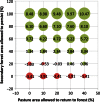Carbon sequestration potential of second-growth forest regeneration in the Latin American tropics
- PMID: 27386528
- PMCID: PMC4928921
- DOI: 10.1126/sciadv.1501639
Carbon sequestration potential of second-growth forest regeneration in the Latin American tropics
Abstract
Regrowth of tropical secondary forests following complete or nearly complete removal of forest vegetation actively stores carbon in aboveground biomass, partially counterbalancing carbon emissions from deforestation, forest degradation, burning of fossil fuels, and other anthropogenic sources. We estimate the age and spatial extent of lowland second-growth forests in the Latin American tropics and model their potential aboveground carbon accumulation over four decades. Our model shows that, in 2008, second-growth forests (1 to 60 years old) covered 2.4 million km(2) of land (28.1% of the total study area). Over 40 years, these lands can potentially accumulate a total aboveground carbon stock of 8.48 Pg C (petagrams of carbon) in aboveground biomass via low-cost natural regeneration or assisted regeneration, corresponding to a total CO2 sequestration of 31.09 Pg CO2. This total is equivalent to carbon emissions from fossil fuel use and industrial processes in all of Latin America and the Caribbean from 1993 to 2014. Ten countries account for 95% of this carbon storage potential, led by Brazil, Colombia, Mexico, and Venezuela. We model future land-use scenarios to guide national carbon mitigation policies. Permitting natural regeneration on 40% of lowland pastures potentially stores an additional 2.0 Pg C over 40 years. Our study provides information and maps to guide national-level forest-based carbon mitigation plans on the basis of estimated rates of natural regeneration and pasture abandonment. Coupled with avoided deforestation and sustainable forest management, natural regeneration of second-growth forests provides a low-cost mechanism that yields a high carbon sequestration potential with multiple benefits for biodiversity and ecosystem services.
Keywords: biodiversity; biomass accumulation; carbon mitigation; ecology; forest regeneration; forest regrowth; secondary forests; tropical forests.
Figures



References
-
- Houghton R. A., Byers B., Nassikas A. A., A role for tropical forests in stabilizing atmospheric CO2. Nat. Clim. Chang. 5, 1022–1023 (2015).
-
- Pan Y., Birdsey R. A., Fang J., Houghton R., Kauppi P. E., Kurz W. A., Phillips O. L., Shvidenko A., Lewis S. L., Canadell J. G., Ciais P., Jackson R. B., Pacala S. W., McGuire A. D., Piao S., Rautiainen A., Sitch S., Hayes D., A large and persistent carbon sink in the world’s forests. Science 333, 988–993 (2011). - PubMed
-
- Wright S. J., The carbon sink in intact tropical forests. Glob. Chang. Biol. 19, 337–339 (2013). - PubMed
-
- FAO, Global Forest Resources Assessment 2015. How Are the World’s Forests Changing? (FAO, Rome, Italy, 2015).
-
- Aide T. M., Clark M. L., Grau H. R., López-Carr D., Levy M. A., Redo D., Bonilla-Moheno M., Riner G., Andrade-Núñez M. J., Muñiz M., Deforestation and reforestation of Latin America and the Caribbean (2001–2010). Biotropica 45, 262–271 (2013).
Publication types
MeSH terms
LinkOut - more resources
Full Text Sources
Other Literature Sources

